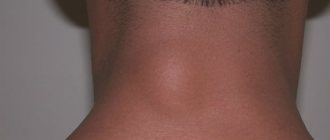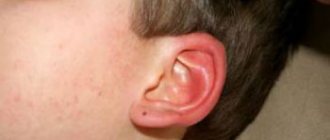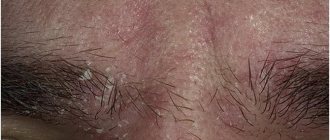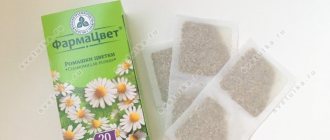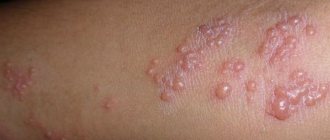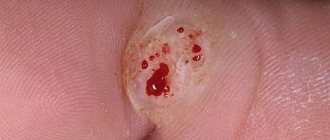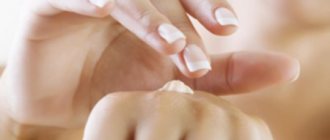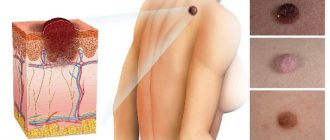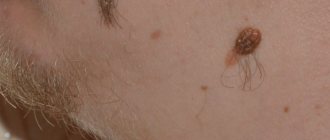Causes of axillary hidradenitis
Hidradenitis (popularly “bitch udder”) is an inflammatory disease that affects the human apocrine glands, which can occur in several forms. The most common form of hidradenitis is under the arms, since the largest number of apocrine sweat glands are concentrated in this area.
Video: what is hidradenitis
Doctor's note: the disease has a specific age range - from approximately 15 to 50-60 years, since its occurrence is associated with the activity of certain glands, and they begin to function during puberty and their activity gradually fades with age (in women up to before menopause). Therefore, it is precisely people in this age range who are at risk.
Apocrine glands are especially active during human puberty.
Hidradenitis develops as a result of penetration into the tissue and activity of pyogenic bacteria, in particular staphylococcus. A problem can form in the presence of certain factors in the patient’s life, which create favorable conditions for the inflammatory process:
- diseases of the central and autonomic nervous systems;
- poor diet, eating junk food or fasting;
- chronic diseases, especially those associated with absorption processes in the stomach;
- strong emotional stress;
- disruption of the endocrine system;
- hormonal disorders and long-term treatment with strong hormonal drugs;
- decreased immunity;
- frequent exposure to x-rays;
- improper depilation of the axillary zone, due to which multiple microlesions are formed in this area;
- neglect of banal hygiene rules.
Features of the child
Hidradenitis in children is a direct consequence of protracted infectious diseases, eczema, diaper rash, and severe sweating. Parents need to monitor how often the child washes his hands and how carefully he observes personal hygiene.
Reasons for the appearance of a lump, ball or lump under the arm: what to do, which doctor to see?
Any compaction in the body causes concern for one’s health, and the armpit area is no exception. Seals can be a manifestation of a serious illness or a minor health problem.
There is no need to worry ahead of time; it is important to consult with a doctor as soon as possible in order to begin the necessary treatment and not aggravate the condition.
The article describes all the known causes of the appearance of balls under the arm and recommendations for further actions.
A lump under the armpit is a lump that may or may not be painful.
More often occurs when hygiene is not observed, wearing tight clothing, or after cuts. But there are cases when a hard ball signals a serious illness.
What does the lump mean and who treats it?
If a lump appears under the armpit, an inflammatory process may be developing.
This can be easily calculated by its appearance:
- reddened skin around the lump;
- hot skin in the area of education;
- deterioration of general condition.
The ball can be singular or plural. It looks like an abscess, tumor, or small nodule. This can be seen in the photo. The tumor does not divide people by age, so lumps can occur in anyone, even a newborn baby. The sooner the problem is identified, the sooner the problem can be solved.
Doctors who study and treat people with such cases identify a number of factors that contribute to the development of a solid tumor in the armpit.
We are talking about the following reasons:
- obstruction of an exocrine organ;
- inflammation of the lymph node;
- hidradenitis
Small tumors may indicate a recent pathology caused by infection. In this case it is a complication. Without certain knowledge, the growth can easily be confused with a boil; the ball hurts when pressed.
They are similar in appearance, only there is pus inside. At the last stage of ripening, it bursts and pus comes out.
Few people know which doctor to contact with a lump. All pathologies associated with purulent inflammation are dealt with by a purulent surgeon. If a small knot appears under the arm, do not panic; it is better to immediately seek help to identify the cause.
A timely visit to a doctor eliminates the risk of prescribing surgical intervention.
If the pathological formation is not advanced, he will tell you which doctor to go to, other than the surgeon. The patient is referred to an infectious disease specialist. Diagnosis is carried out to exclude serious diseases that may be accompanied by inflammation of the lymph nodes.
Appearance
Tumors come in different forms, and their appearance also varies slightly.
The following formations are found:
- small and medium in size;
- soft consistency, dense;
- the lump under the arm hurts when pressed, without pain;
- flesh-colored or closer to dark burgundy, without redness;
- smooth or ridged tissue around the area of inflammation;
- internal localization or protruding on the surface.
These manifestations are important when making a primary diagnosis. You can recognize oncology if several factors are combined, these are: redness, enlargement of a nodule under the skin, painful sensation, immobility.
The exact cause is determined by the doctor, based on the appearance of the ball and the patient’s condition.
Causes
Most often, the reasons for the development of a lump under the arm are related to the lymphatic system. When you touch it, you can feel a singular nodule, a non-painful tumor. The formation can move when pressed or be stationary. Skin color does not change.
In this case, we can talk about conditions such as:
- cuts, purulent wounds near the affected area;
- the presence of arthritis, arthrosis in the area of the elbow, wrist, shoulder;
- eczema, psoriasis on the hand where the ball appeared;
- pulmonary tuberculosis;
- obstructive bronchitis, pneumonia;
- hidradenitis;
- myocarditis.
When a malignant or benign formation occurs, the person is prescribed measures that identify serious pathologies. If you ignore it for a long time, there is a risk of oncology. In the final stages of this disease, the prognosis is poor.
In adults and children
If a lump appears in men, poor hygiene is often to blame. As a rule, hidradenitis develops. The disease occurs with poor genetics and excessive sweating. The disease also appears in adults who have had diabetes.
It is important to be careful when shaving your underarms. Cuts and minor abrasions should be avoided. The latter most often causes a lump under the armpit in men. If a man's razor is not cleaned after each shave, there is a risk of infection and, consequently, the development of formation.
If a ball has formed under the armpit and it hurts, this does not mean the presence of cancer.
Lumps under the armpit in women are more often a pathology. You shouldn’t run it, because the consequences are different. It is important to promptly identify the cause and begin treatment.
If a lump hurts, it will not always be malignant. This may be a cyst that resolves after gentle therapy or is removed during one of the non-hazardous procedures. The prognosis is good.
There is a risk that biopsy and colcoscopy show poor results. We are talking about the growth of a cancerous tumor and the proliferation of metastases. The outcome depends on the speed of response to the pathology. The surgeon will definitely decide to remove the malignant lesion.
The situation is dangerous because the mammary glands are located near the armpit. In advanced cases, a woman may lose her breasts.
In children, lymph nodes enlarge due to infection and the development of tumor processes. A metabolic disorder called “storage disease” is also affected.
A local, separate formation is located next to the source of inflammation. Therefore, it is worth carefully examining the child’s hand and shoulder blade where the lump appeared. In the case of children, it is important to carry out timely diagnostics to study the spread of compaction to other areas.
What to do after a ball appears
If a lump appears under the arm and it hurts, it is prohibited to carry out therapy on the body without a doctor. Incorrect treatment will lead to the growth of “bad” tissues. This is especially true for warming up.
In the case of bumps under the skin, compresses and heating pads are strictly not recommended. On the contrary, peace is ensured and the skin in the armpit is kept clean.
Doctors warn! Shocking statistics - it has been established that more than 74% of skin diseases are a sign of parasite infection (Accarida, Giardia, Toxocara).
Worms cause enormous harm to the body, and the first to suffer is our immune system, which should protect the body from various diseases.
The head of the Institute of Parasitology shared the secret of how to quickly get rid of them and cleanse your skin, it turns out that it’s enough... Read more...
When you first feel a nodule under the skin in the armpit area, you should consult a doctor. He will prescribe tests, diagnostics, tell you what it could be, and name the reason. You need to pay close attention to your child’s education. In childhood, this is how leukemia and oncological pathologies manifest themselves.
A lump has appeared under the armpit - what it could be, how to treat it
A small lump under the arm is a good cause for concern for many. It may indicate the presence of an inflammatory process in the body. The neoplasm in most cases has a round shape. When pressing on it, pain is felt.
https://www.youtube.com/watch?v=pKmn3HmEVa8
Although sometimes there is no pain at all when touching the lump. Without prior consultation with a specialist, it is unlikely that you will be able to find out what the seal actually is and whether it is dangerous to health.
The lump may have a different color. Most often, a greenish or red lump is observed. It also comes in white. Due to its size, the tumor stands out well under thin skin. Therefore, it is quite easy to detect.
A lump in the armpit that hurts is the first sign of inflammation. It is usually accompanied by symptoms such as fever and redness at the site of the lesion.
In this situation, we can talk about the appearance of an inflamed node, abscess or tumor in a person’s armpit. It is also worth considering the fact that a lump does not always occur alone. It is not so rare that doctors have to observe several neoplasms under the skin at once.
Main reasons
Specialists who research and select therapy for patients with such cases identify several main factors that contribute to the development of a dense tumor in the armpit. It occurs for the following reasons:
- Blockage of the sebaceous glands.
- Lymphadenitis or inflammation of the lymph node.
- Hidradenitis or inflammation of the sweat ducts.
Source: https://mgkb01.ru/prichiny-poyavleniya-pod-myshkoy-komka-sharika-ili-shishki-chto-delat-k-kakomu-vrachu-obratit-sya/
Symptoms of the disease
The first manifestation of hidradenitis under the arm is the formation of one or several dense nodes under the skin, which can be up to 3 centimeters in size. They are characterized by a gradual increase and often a change in color - from red to rich crimson tones. The inflammation gradually spreads, affecting more and more healthy sweat glands. Patients experience clearly localized itching and pain in the affected area.
Axillary hidradenitis may gradually increase in size and become dark in color.
Specialist's note: the manifestations of hidradenitis in the first stages are similar to the formation of boils, however, with hidradenitis suppurativa, the formation does not have a core and can be round or irregular in shape.
As hidradenitis develops, other symptoms appear, including:
- increase in the size of nodules;
- the formations are soldered to the skin and their shape becomes pear-shaped;
- around the nodules there are pronounced edematous areas;
- increased pain; with significant lesions, it is even difficult for the patient to move his arm;
- the nodes noticeably rise above the skin and visually resemble dog nipples - because of this, the disease received its popular name “bitch udder”;
- formations gradually begin to merge with each other;
- the nodes can open spontaneously, the nature of the discharge is pus, sometimes mixed with blood;
- after opening, the ulcer gradually begins to scar;
- at the stage of inflammation, hidradenitis provokes severe malaise, weakness in the body and a significant increase in temperature.
The disease can occur in a unilateral form or affect the armpits on both sides of the body.
Characteristic symptoms
The suppurative process caused by staphylococci is most often localized in the armpits. On the first day, a small lump appears in the affected area. In the following days, you can notice the growth of the seal, which takes the shape of a nipple. In the affected area, the patient begins to experience very severe itching, and then pain when trying to scratch the affected area.
Enlargement of the affected area indicates the development of hidradenitis
With the further course of hidradenitis, the patient begins to feel pain regularly, and in some cases an increase in body temperature is observed.
On average, after a week, the purulent node matures, which subsequently breaks through.
In the absence of timely treatment, “bitch udder” can cause the development of an abscess or even sepsis.
Diagnosis of the problem
Diagnosis of the disease is not difficult; a visual examination by a specialist will be sufficient. However, several tests may be performed to confirm hidradenitis:
- blood test - shows an increase in the level of leukocytes due to the development of a purulent type of inflammatory process and a decrease in red blood cells, which indicates the formation of inflammatory foci;
- to determine the causative agent of the disease, it may be necessary to collect the contents of the formed node;
- a protracted form of the disease may require additional research on the patient’s immunity status.
The effectiveness of treatment is largely determined by timely access to a doctor. This should be done when the first signs of hidradenitis are detected: the appearance of pain in the armpit area and the formation of small purulent nodules.
Symptoms and signs
The stages of formation of hidradenitis are similar to the stages of formation of boils and carbuncles. But their symptoms and signs are different.
The process of development of a boil and carbuncle begins with the appearance of a pimple with a purulent tip. With hidradenitis - subcutaneous nodes without a necrotic core. The abscess grows upward, and inflammation of the apocrine glands occurs in the deeper layers of the skin. It begins with a barely noticeable itch, the skin color changes greatly, and becomes bluish. The furuncle, ripening, “blooms” and turns red. It causes a throbbing pain that can be tolerated. With hidradenitis, the pain is diffuse. If inflammation of the apocrine glands develops in the armpit, the patient cannot lower his arm. Hidradenitis in the perineum makes it difficult for a person to move.
On average, inflammation of the apocrine glands lasts 10-15 days. A furuncle matures and breaks out in seven days, a carbuncle - in 14-20 days.
Treatment
Drug therapy: antibiotics, ointments
Hidradenitis can be treated in several ways. Drug treatment is mandatory; it involves prescribing the following groups of drugs:
- antimicrobial therapy to neutralize the activity of the pathogen (erythromycin or tetracycline);
- antiseptic preparations for local treatment of lesions under the arms (boric alcohol, tincture of iodine, Neomycin ointment, Vishnevsky ointment, etc.);
- in some cases, it may be necessary to prescribe glucocorticoids (steroid hormones) to influence the inflammatory process;
- local application of ointments containing antibiotics (Levomekol, Erythromycin, etc.) or to accelerate skin regeneration processes;
- with prolonged hidradenitis, immunotherapy is required (most often, a special staphylococcal vaccine is prescribed).
Important! It is better not to practice treatment at home to avoid serious complications.
Photo gallery: drugs prescribed for hidradenitis
Boric alcohol is a fairly common remedy, but it is better not to use it without consulting a doctor.
Levomekol - white ointment for external use
Tetracycline - the drug has a broad spectrum antibacterial effect
Erythromycin is a bacteriostatic antibiotic for external use.
Surgical intervention
In advanced cases, surgical intervention is necessary, but it does not exclude drug therapy. The operation consists of opening the lesion and completely clearing it of purulent contents. This is necessary to prevent dangerous complications of hidradenitis. If the inflammatory process is very widespread, it may be necessary to remove a large area followed by skin transplantation.
If you have hidradenitis under the arm, it is strictly forbidden to open the formed nodes yourself, as this can provoke the spread of infection and worsen the situation. Also, you should not steam in the bathroom and allow a large amount of moisture to get into the affected area - this will create additional conditions for the development of infection.
Using folk remedies at home
In the fight against hidradenitis, folk remedies are often used. The main essence of treating the disease is to neutralize the pathogen, so antibiotic therapy cannot be abandoned, however, folk remedies can be used as additional ones. The following recipes will be relevant:
- in the initial stages, applying cabbage leaves at night gives a good effect;
- aloe juice provokes the opening of the abscess, as if sucking out the pus. For the procedure, you need to take a leaf of the plant, cut it lengthwise and apply it to the site of suppuration;
- celery leaves are crushed into a paste and applied to the armpit for half an hour. The procedure can be repeated up to 5 times a day;
- You can wash the opened node with a herbal decoction of chamomile, sage, calendula and eucalyptus. Brew herbs in a standard proportion - a tablespoon per glass of boiling water.
Inflammation of the sweat glands in the armpit: causes
Of course, first you should understand the reasons for the development of the disease, because the treatment regimen chosen by the doctor largely depends on this.
In most cases, inflammation of the sweat glands in the armpit is associated with the activity of pathogenic bacteria. According to statistics, Staphylococcus aureus most often plays the role of pathogen. Most often, microorganisms penetrate the gland from the outside, through its duct. This often happens with various damage to the skin, for example, during hair removal or shaving, as well as as a result of constant friction of the skin against the fabric.
By the way, hyperhidrosis (excessive sweating) is also potentially dangerous. The skin in the armpit area constantly gets wet, the tissues become macerated, which leads to a weakening of the barrier functions. Under such conditions, it is much easier for pathogenic microorganisms to penetrate the sweat gland or deep skin layers.
Infection, by the way, can enter tissues not only from the external environment. The infection often spreads throughout the body along with the flow of blood and lymph. Of course, this only happens against the backdrop of a weakened immune system.
Possible complications
From the point of view of possible complications, hidradenitis is a very dangerous disease. The lack of necessary therapeutic measures can cause a number of difficult situations:
- large-scale spread of the inflammatory process;
- formation of an abscess (a purulent abscess at the site of inflammation);
- formation of fistula tracts (abnormal connections between hollow organs, skin and organs, etc.);
- spread of infection, up to sepsis (general infection of the body).
The highest risk of complications is in patients with a reduced level of immune defense.
Main risk factors
Of course, inflammation of the sweat glands in the armpit is associated with the activity of staphylococcal infection. However, the likelihood of developing the disease is much higher if the body is severely weakened.
That is why it is worth studying the risk factors:
- diabetes mellitus (accompanied by serious hormonal disorders and weakened immunity);
- diseases of the endocrine system;
- tuberculosis;
- the presence of HIV infection, as well as other immunodeficiency conditions;
- toxoplasmosis;
- helminthic diseases (infestation of pinworms, roundworms, etc.);
- rheumatic diseases;
- systemic lupus erythematosus;
- anemia (tissues do not receive enough oxygen, which weakens their barrier functions);
- following a strict diet (this depletes the body, making it more susceptible);
- poor nutrition (again, leads to the development of vitamin deficiencies);
- obesity (overweight people often suffer from hormonal disorders and excessive sweating);
- severe hypothermia (local or general);
- pregnancy period (associated with hormonal changes).
All these diseases significantly weaken the body's defenses, negatively affect the immune system, and make the skin more susceptible to infection.
By the way, the inflammatory process can develop against the background of an allergic reaction caused by the use of low-quality cosmetics: antiperspirants, face washes, etc.
Conservative treatment
Since inflammation is associated with the activity of bacterial microorganisms, the treatment regimen necessarily includes taking antibiotics. Erythromycin and Doxycycline and Tetracycline are effective. Therapy lasts at least two weeks.
The affected tissues, as well as the skin around the abscess, should be treated with antiseptic solutions 2-3 times a day. This will help prevent further spread of bacteria. For disinfection, a solution of salicylic acid, tincture of iodine, brilliant green, and alcohol are suitable. Also, inflamed tissues are lubricated with Vishnevsky ointment or Levomekol.
If during the tests it was possible to confirm the presence of a staphylococcal infection, then specific therapy can be carried out, in particular, the administration of staphylococcal gamma globulin. Non-steroidal anti-inflammatory drugs are also used to help cope with pain and fever.
Hidradenitis
Purulent inflammation of apocrine sweat glands. It occurs under the influence of staphylococci and streptococci that penetrate the glandular tissue through ducts or wounds in the skin. With this disease, the lump under the armpit hurts and itches. Body temperature rises and chills occur. The skin over the inflammation becomes purplish-red, and over time, pus begins to ooze from the center of the affected area. Treatment involves taking antibiotics and external treatment with antiseptics. Physiotherapy is also carried out and bandages with antibacterial ointments are applied.
Clinical manifestations
Foci of purulent inflammation of the sweat glands develop in the deep layers of soft tissue. At first, the inflamed area swells, causing slight discomfort, then, as purulent masses accumulate, the pain intensifies.
The first symptom of hidradenitis is the formation of small, dense red nodes that feel painful when pressed. After a few days, the symptoms of hidradenitis intensify, because... the abscess increases in size, blood circulation in it is disrupted, which is why the skin over the formation becomes bluish or dark burgundy.
The peak of the disease occurs approximately on the tenth day, when the neoplasm rises above the surface with a large hemisphere, the size of a chicken egg. At this time, a person is severely limited in movement, friction (whether from clothing or another factor) only increases discomfort.
In this case, the following symptoms of hidradenitis are observed:
- loss of strength, general weakness and fatigue;
- inflammation of the sweat glands and severe pain, even at rest;
- nausea, dizziness;
- heat.
Inside the abscess, the tissue softens, and spontaneous opening of hidradenitis occurs. After the expiration of the contents, which consists of yellow-green pus and turbid liquid, the swelling gradually decreases, the pigmentation of the skin turns pale, and health returns to normal. Gradually, the wound heals, scar tissue forms at the wound site, which smoothes out over time.
In order to avoid a complicated course of the disease, you should promptly seek qualified advice.
Diagnostics
With hidradenitis, the symptoms are very obvious, so it is difficult to confuse it with any other disease. To determine the type of pathogen and prescribe appropriate treatment, a specialist may prescribe laboratory tests:
- general blood test - the number of leukocytes and ESR (erythrocyte sedimentation rate) are determined;
- analysis of purulent discharge - bacterial culture of the sample is carried out for nutritional microflora to determine sensitivity to antibiotics.
- immunogram – prescribed for prolonged inflammatory processes.
If the disease is advanced and fistulous tracts have formed, an ultrasound (ultrasound examination) of the soft tissues is necessary to identify the extent of the damage and correct actions during surgery for hidradenitis.
Axillary lymphadenitis
An inflammatory process in the lymph node due to the occurrence of a focus of infection in the body. The serous form of the pathology is accompanied by the appearance of a hard lump under the armpit. The seal hurts when pressed. There is no general deterioration in health. With purulent lymphadenitis, the temperature rises, chills and nausea occur. Redness and swelling are accompanied by severe pain. If the pathology arose as a result of another infection, after the primary disease is cured, the tumor subsides. In case of independent suppuration of the node, the lump is opened and the contents are removed. Antibiotics for external and internal use are also indicated.
